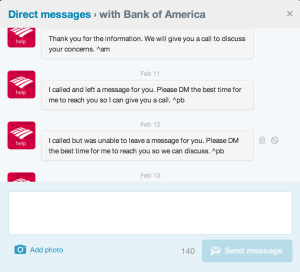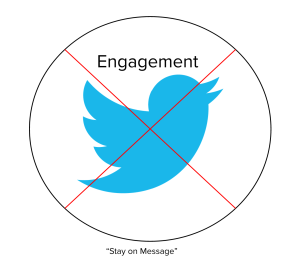The Time Bank of America Stalked Me: Or How Not to Do Social Media
It all started innocently enough. I had just made a series of online purchases using my Bank of America debit card, paying for an account on Squarespace, and a couple of related services, for a website I was making. The purchases happened over the weekend, and on tuesday I got the email.
Bank of America card security is the bane of my existence. I live in Europe, but maintain an American bank account for the considerable ease it provides in making online payments, where payments in Europe entail a lot more red tape (plus Netflix!). But Bank of America doesn’t like Europe. Not one bit. My card is shut off for fraud protection on a regular basis. Because I bought an unusual item (a mattress), because I used it in a different city than usual (Karlovy Vary), because I used it too much in one day ($400), and it is shut off, like clockwork, minutes after I arrive in any country, other than the one I was in the last time it was shut off. This has given rise to a little ritual I now have with Bank of America. When I arrive in a new country, I take out the equivalent of $200 from a bank machine, wait a couple of hours, then call their international fraud prevention hotline (toll free), to assure them that it’s really me.
To make a long story short, Bank of America wanted to cancel my debit card because it had been compromised by one of my online transactions, apparently. The only problem was, that I had already been waiting for a replacement to my credit card, also with BofA, for nearly 4 months. Now I would have no cards with which to pay for my beautiful Netflix, Spotify, and… other things that I pay for online.
I made the call, and after various hijinks and extremely long and uncomfortable pauses, the cards were their way: 30 minutes on the phone. Not my worst outing. Not my best. I was annoyed with the whole thing, and the crazy trance music they were playing was bizarre to listen to at 3 in the afternoon on a weekday.
That’s when it got interesting.
I flipped over to Twitter and posted this missive:
To be fair to me, I’m just being cheeky. And the techno music is god-awful. Why do I feel like I need to be on crystal MDMA to enjoy making a business call? But I wasn’t really upset, just bemused. If there was an emoticon I should have employed, it would be that slanty chagrined one like this :/ that indicates something like: “meh…” I certainly never expected a response. That’s when things got a little weird.
Bank of America representatives, I think at least 2 separate people on the same account, attempted to contact me by DM to get my phone number. That’s a little weird, I thought. I initiated this conversation online, and they want to call me on the phone.
I gave my number, out of bemusement more than anything else, and then they proceeded to call me. 7 times, in 2 days. Each time they called, they also repeated a DM on twitter asking me to get back to them with a better time to call. But I was feeling a little trapped at this point. I had put myself in this situation, and I just wanted out of it.
However, given the time difference between Prague and wherever they were calling from, they only succeeded in actually getting me on the phone once, at about 9 in the evening, when I told them I was at an art class with my wife, and I would not be speaking to bank representatives on the phone. The support person wasn’t clear on the concept of there being different times in different parts of the world. She called me back at about 1am. I didn’t want to just say: “hey, listen, I was just being sarcastic, it’s fine, and please change your horrible holding music.” This was feeling like I had done something wrong, and was being held to account for it.
Your Customers are Not Problems: They Are Opportunities
It just so happens that an alum of StartupYard, Brand Embassy, recently announced a major new round of seed funding. Brand Embassy is very cool, and if you run a medium to large software company, or engage a lot of social media (enough to have a social media team), then you should check it out. I used it myself in a previous position, when it was still very much in early Beta, and it’s gotten even better since then.
I don’t know if Bank of America is a client of theirs (they should be if they aren’t), but even if they were, software can’t protect a company from making grave errors in how it deals with its customers in social media. Software can make sure you don’t miss things; make sure you’re keeping up with the traffic, but it can’t give you a sense of humor. It can’t make you treat people like *people* instead of like points of data. On this front, Bank of America acts just like you’d expect a bank to act.
I think I know what happened though. I think I get why this situation unravelled the way it did. Bank of America is probably using a suite of software similar to Brand Embassy, which assigns social media representatives to specific cases and interactions, and can be monitored by a team leader, producing cool metrics and satisfyingly productive data that tells you how your social media interactions are progressing. There are probably goals involved that try to turn negative initiated interactions, like mine, into positive viral feedback. My tweet had to be about a problem, and that problem had to find a solution. Acknowledgement alone was not in the playbook for them.
At the end of this whole thing, when some poor young person had mollified me on the phone, and promised a muffin basket (or whatever), I was supposed to rave about how great Bank Of America is at handling its customers. Nevermind that they could spend time hiring and training for their inbound call centers so that when you call them, they can handle your actual customer care complaints more effectively. I understand that the social space exists, and is fast eclipsing inbound customer care anyway, for many reasons. And that’s all ok. But a lot of the time, people use social media to be provocative, and sometimes the best reaction to provocation is to be provoked. Mix it up. Toss in a right-hook. It’s a risk, but it might be worth it.
Social Media Should be Used to Excite, not Defuse
Except in this case, software, or whatever protocol Bank Of America must have to manage it’s doubtlessly vast legion of social media reps, assigned my “case” to a representative, and a case demands “resolution.” I had been made into a number, and that number had to be rounded off, one way or the other. My comments had to be “dealt with,” rather than “engaged with.” I can imagine the number of people involved in shaping the language that goes into what these reps are allowed to tweet to people. And nothing kills creativity faster or deader than a committee. Because it’s always easier to say no to risks, than to take them.
I’ve managed social media accounts with tens of thousands of followers. And it’s a double-edged sword. I can understand Bank of America not wanting to engage with petty bickering, or wanting to even *attempt* to poke fun at itself by acknowledging my own dry remarks with a bit of humor. The divide and conquer approach is safer, and I’m sure their numbers prove it. With a half million followers on a corporate social media account, the great temptation is to monetize that resource: to turn it into a channel for spreading your marketing message of the day, and to split off and minimize chatter and negativity as much as possible. Most companies can’t resist that siren call in the twitterverse. And that’s a real problem. But Twitter is taking steps to make the “divide and conquer” approach of sock-puppeting corporate accounts less attractive.
There’s a world of milk and honey beyond corporate speak, in the Twitterverse. There is an opportunity in social media to engage with customers, to get to know them, and to talk to them on their own level. Instead of flattening out everything into a bland corporate pancake, Twitter and other social media allow a rep to quickly, and incredibly easily figure out who they’re talking to, and talk back.
My website is listed on my twitter profile. In 30 seconds, a rep could have known what I do, where I work, and what my sense of humor is like. They could have found the StartupYard blog in about 3 clicks, if they thought about it. And then they could have spent a minute personalizing a response, and delighted a long time customer with a little acknowledgement. But they didn’t do that- they spent untold amounts of time trying to get me on the phone, where someone who still didn’t know anything about me would try to “handle” me and my non-problems. That’s an awful shame, really.
Content Matters. Not Just *Your* Content.
The essential issue here is that big companies are comfortable with “marketing,” as a concept, and with “customer care,” as a concept. But they are not ready for “marketing with customer care,” as a new mode of engagement with customers. Solving customer problems is one thing, but sometimes customers just want to feel acknowledged as human beings. And sure, plenty of companies are faking this kind of customer engagement with large-scale “viral” opportunities, but that isn’t the same thing. In that kind of scenario, the company controls the environment, selects customer reactions, and manages the content. Social media is not built for the perfectly polished story: it is built for the rough and ready. It is built for letting consumers create the narrative.
Thus, I present my vision of the ideal tweet: the tweet that is special because it actually accomplishes something new:
By pushing our interaction, which initially consisted of me poking a little fun at their byzantine call center operations, into a “real life,” or at least “real telephone,” interaction where I was being put in the position of explaining myself to someone, BofA made a mistake. They silenced a member of their herd, who will no longer feel comfortable engaging with them in social media again. They pushed the interaction as far as possible to the right: customer care land. They tried, rightly, to acknowledge me, but they didn’t play fair and give something back. Perhaps that’s the point, but consider this: your angry customer is also your most valuable. He or she is going to be the person who tells you what you can do to improve. Instead of being a mouthpiece for your brand (because social media is sadly ALL about brand, and not about real communication for big companies), an angry or a complaining customer is an opportunity for you to learn, and to demonstrate that you *can* learn.
Here’s how I’d have liked to see my “case,” handled at BofA. A customer care account should have tweeted: “thanks for the advice [insert quip about techno music]. We’ll bring that up at the next meeting. Anything else we can help you with?” At 132 characters, that gives me total satisfaction. Hey! A big company noticed me! I’m a hero! If the music ever does change (it’s always possible), I might become an evangelist for the BofA brand anyway. They really listened to me! They care about me! BofA could even highlight the interaction if they did decide to change something, featuring my tweet, and announcing that they were adding some cool bands to their hold music library.
Ok, that’s a little far-fetched, but still. They could do something like that. That would at least be fun, and possibly even funny. Banish the thought of a company that size doing something engaging like that!
But they didn’t listen- they didn’t acknowledge the content of my tweet at all. They just side channelled me away from Twitter entirely. God knows what I could have accomplished by talking to them on the phone. A satisfying coda to my BofA experience, when I had been complaining about having to talk on the phone with them in the first place?
[ssba]
Disclaimer: Bank of America is staffed by nice and helpful people, and they are not in any way meant to be portrayed here as a villain. My opinions are my own, and are not meant to be interpreted as those of StartupYard or its partners.






